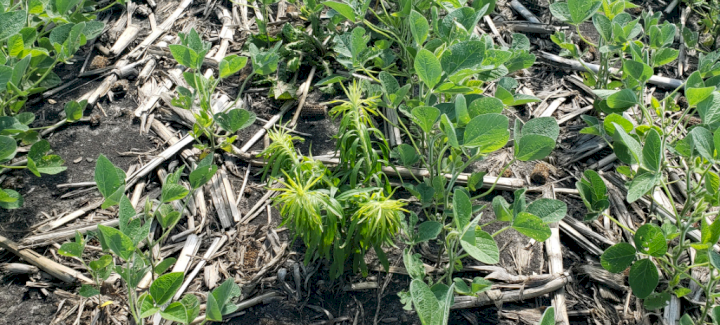Part 3: Management Strategies for Difficult-to-Control Weeds (Driver Weeds) in Soybeans
November 2019
Marestail, otherwise known as horseweed, has been problematic for growers since the early 2000s, when the first glyphosate-resistant form was found in the United States. Because of this weed’s prevalence throughout the country, combined with the sheer size of the plant and number of seeds it produces, marestail is the focus for Part 3 of our series on herbicide-resistant and other hard-to-control driver weeds. This week we examine the strengths and weaknesses of marestail and recommended control tactics.
The Bad News (Strengths)
- Marestail is a winter annual that emerges in the late summer through the fall and in early spring. Fall-emerging weeds typically overwinter and “bolt,” or develop a long stem with leafy growth that is difficult to control.
- Bolted marestail is difficult to control because it can have hundreds of growing points.
- Marestail can grow 6–8 feet tall and develop 200,000+ seeds per plant that can be blown by the wind and carried by birds.
- Marestail has smaller leaves, making coverage difficult.
- Marestail can become hardened off in poor growing conditions, including hot and dry periods and extremely wet periods.
- If left uncontrolled, marestail can reduce yields by as much as 40 percent.
The Good News (Weaknesses)
- Marestail is relatively easy to control in the rosette stage, compared to the bolted phase. This happens in the 30–45 days after emergence in the fall and 21–30 days after emergence in the spring.
- Marestail responds well to soil-applied herbicides that inhibit root and shoot development.
- Fall cover crops such as cereal rye have proven effective at keeping marestail from germinating in the fall and provide a shading effect to emerging marestail in the spring if left in the field after termination.
- Corn and small grains are a good rotational option to fight marestail because there are more chemical options in these cropping systems.
Management Strategies
- Start clean. For marestail, this means you will need to start in the fall. Apply a fall burndown to actively growing, emerged marestail. Consult your local agronomist or university extension office for specific recommendations.
- Control new and surviving weeds with a spring burndown.
- Use soil-applied residuals at planting to guard against late-emerging marestail.
- For post-emerge applications, target weeds less than 6” tall using multiple herbicides with adequate coverage.
- In some cases, narrow-row soybeans may be warranted to increase photosynthetic competitiveness and decrease marestail emergence.
- Cover crops have shown an increased ability to delay emergence and shade emerged seedlings.
- Cultivation in severe infestations may be necessary for a few years to get the population under control.
- Conventional tillage demonstrates a more effective control because weeds are uprooted in the spring. In severe cases of poor marestail control, conventional tillage in the spring may be warranted.
Trait System Usage
Use trait systems that provide the ability to apply multiple, effective modes of action simultaneously to combat herbicide resistance. For instance, the Enlist E3® system allows Enlist One® with 2,4-D choline to be applied with both glyphosate and glufosinate and additional tank mix partners to eliminate and delay further marestail emergence. This system combines many of the strategies discussed into a flexible platform.
To learn more about marestail and how to manage this hard-to-control driver weed on your farm, contact your local Stine agronomist or university extension specialist.
Resources and Citations
Management of Herbicide-Resistant Horseweed (Marestail) in No-Till Soybeans
https://iwilltakeaction.com/uploads/files/57229-7-ta-hrm-factsheet-horseweed-final.pdf
Plant of the Week
https://www.uaex.edu/yard-garden/resource-library/plant-week/horseweed-8-5-05.aspx
Marestail
https://u.osu.edu/osuweeds/super-weeds/marestail/
Marestail (Horseweed) Management
https://extension.psu.edu/marestail-horseweed-management
Adapting Soybean Burndown Programs for Large Marestail
https://agcrops.osu.edu/newsletter/corn-newsletter/2017-12/adapting-soybean-burndown-programs-large-marestail
Related Articles
-

Stine® to offer Syngenta’s Victrato® soybean seed treatment in 2026
December 2025 in Agronomy
-

Use Stine’s XP® seed treatments to prevent early injury to your crops
December 2025 in Agronomy
-

Understanding Stine’s enhanced oil profile soybeans
December 2025 in Agronomy
-

Soil sampling sets the stage for spring
November 2025 in Agronomy



